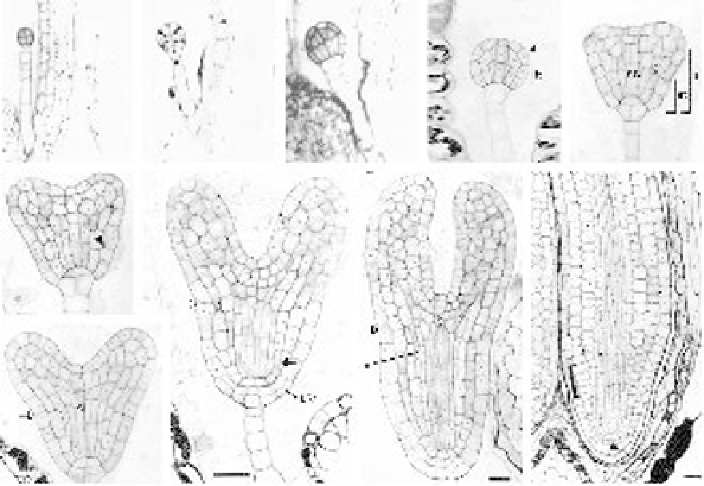Agriculture Reference
In-Depth Information
E
A
B
C
D
F
H
I
J
G
Figure 8.1
Stages of
Arabidopsis
embryogenesis: (A) octant stage; four of eight cells; (B) dermatogen
stage, the inner cells are separated from the epidermis by a set of tangential cell divisions; (C) early
globular stage, the embryonic axis is visible for the first time; (D) globular stage; (E) triangular stage;
(F) early heart stage; (G) mid heart stage; (H) late heart stage; (I) mid torpedo stage; (J) mature embryo
stage; ut, upper tier; lt, lower tier; llt, lower region of lt; PC, procambium; LR1, 1st lateral root cap
layer; E, endodermis; Closed arrows and arrowheads: cell walls marking divisions. Adapted from
Scheres
et al.
(1994) and from Berleth and Chatfield (2002).
root cap initials are formed. During the next subsequent heart, torpedo and bent
cotyledon (Figs. 8.2F and 8.2H) stages, development of the embryo is concluded
and all tissue types are set in place, leading to a final structure that has similar
structural complexity as that of a seedling. The actual differentiation of most tissues
is delayed until after germination.
During embryogenesis the different tissues form a radially symmetrical pattern
around the apical-basal axis. These layers are established in stages. In
Arabidopsis
,
they start forming just after the octant stage when the epidermal cell layer is created
through periclinal cell divisions. During the succeeding stages of embryogenesis
the other tissues are formed from the inner cells. These cells undergo periclinal
cell divisions, which increase cell number and establish the ground tissue layer and
provascular bundle. At the transition of globular to triangular stage, the provascular
cells divide once more periclinally to separate the pericycle layer from rest of the
vascular bundle. The ground tissue initial cells will also undergo an asymmetric
periclinal cell division to form the endodermis (inside) and cortex (outside) layers.
During the last stage of embryogenesis, cell number in the vascular bundle increases
and the phloem-xylem pattern is completed.









